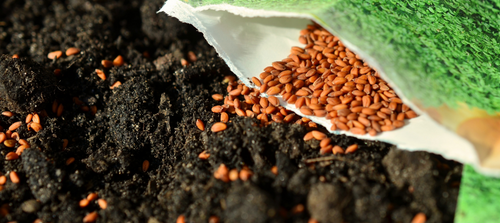Parkway Plant Expert - April 16 2020
Top 10 Tips for Starting Seeds

1. Choose Wisely
Research in the winter to choose the right seeds and work out details of timing and transplanting. Use catalogs that specialize in plants for your region. Keep your catalogs for reference. Decide between hybrids and open-pollinated cultivars. Hybrids may produce earlier harvests and higher yields, but open-pollinated cultivars may taste better, produce longer and cost less. Avoid seeds treated with synthetic chemical fungicide. When ordering, specify untreated seeds. Choose cultivars for size, habit, and tolerance of your soil conditions.
Some sure bets for home germination:
Edibles - basil, broccoli, brussel sprouts, cabbage, cauliflower, chives, leeks, lettuce, onions, peppers and tomatoes.
Annuals - alyssum, cosmos, marigolds and zinnias.
Perennials - Shasta daisies, columbines and hollyhocks.
2. Get the timing down
Calculate when to sow and transplant using area frost dates as a guideline.
3. Gather CLEAN containers
Anything 5-8cm (2-3 inches) deep with holes for drainage will do. Clean by washing in hot, soapy water and rinsing with a 10% solution of household bleach and water.

4. Use seed-starter mix
Do not use regular potting soil to start your seeds. Use seed starter soil or make your own by combining equal parts of perlite, vermiculite, and peat with a 1/4 teaspoon of lime for each ‘armful’ to neutralize the acidity of the peat.
5. Sow carefully per the directions
Sow more finicky transplants into large containers or directly into garden after frost risk is past (e.g. lettuce, melons, cucumbers). Moisten your medium before sowing. Drop seeds onto the surface, spacing as evenly as possible. Cover the seeds to a depth mentioned on packet or about three times the thickness of the seeds. Some seeds should not be covered at all because they need light to germinate so be sure to check the package. Top it off with lightly sprinkled milled sphagnum moss, a natural fungicide, to protect against damping-off, a fungal disease that rots seeds and seedlings.
6. Keep seeds cozy and moist
Cover flats with plastic wrap or glass to keep the environment humid and place them near a heat vent or on a heat mat made for seed starting. Most seeds germinate well at about 21-24 degrees C (70-75 degrees F). Mist with a spray bottle or set the trays into water so the mix wicks up the moisture.

7. Provide LOTS of light
After germination, uncover and move the containers to a bright spot—ideally 5 cms (2 inches) beneath fluorescent lights (NOT incandescent). Rotate seedlings at the edges into the middle every few days. Keep the bulbs clean to maximize light available. Provide 12-16 hours of light per day.
8. Fertilize
Treat seedlings to food and cooler temperatures 10-15 o C (50-60 o F) - Begin to fertilize with a half-strength solution every week or two of fish or seaweed fertilizer, compost tea, or one of the liquid organic fertilizers specially formulated for seedlings. Do this AFTER they get their first true leaves which emerge after the little, round cotyledon leaves.

9. Give them room
To avoid becoming root-bound or overcrowded, thin seedlings and repot into larger containers with a mix that includes compost. Gently use a narrow fork or flat stick to lift the seedlings and handle only by leaves or roots to avoid damaging fragile stems.
10. Toughen them up
Lightly brush seedlings with your hand often each day to help them grow stocky and strong or set up a small fan to gently, continuously blow on them. Start acclimatizing them outdoors (hardening off) 1-2 weeks before the plants are to go into the garden. On a warm spring day, place containers in a shaded, protected place, such as a porch, for a few hours. Each day—unless the weather is horrible—gradually increase exposure to sun and breeze.

